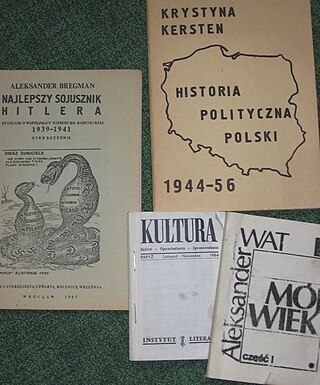
A comic book, also called comicbook, comic magazine or simply comic, is a publication that consists of comics art in the form of sequential juxtaposed panels that represent individual scenes. Panels are often accompanied by descriptive prose and written narrative, usually, dialogue contained in word balloons emblematic of the comics art form.

Publishing is the activity of making information, literature, music, software, and other content available to the public for sale or for free. Traditionally, the term refers to the creation and distribution of printed works, such as books, comic books, newspapers, and magazines. With the advent of digital information systems, the scope has expanded to include digital publishing such as ebooks, digital magazines, websites, social media, music, and video game publishing.

Quotations from Chairman Mao Tse-tung is a book of statements from speeches and writings by Mao Zedong, the former Chairman of the Chinese Communist Party, published from 1964 to about 1976 and widely distributed during the Cultural Revolution.

Print on demand (POD) is a printing technology and business process in which book copies are not printed until the company receives an order, allowing prints in single or small quantities. While other industries established the build-to-order business model, POD could only develop after the beginning of digital printing because it was not economical to print single copies using traditional printing technologies such as letterpress and offset printing.

A small press is a publisher with annual sales below a certain level or below a certain number of titles published. The terms "indie publisher" and "independent press" and others are sometimes used interchangeably.
The bibliographical definition of an edition is all copies of a book printed from substantially the same setting of type, including all minor typographical variants.

An American comic book is a thin periodical originating in the United States, on average 32 pages, containing comics. While the form originated in 1933, American comic books first gained popularity after the 1938 publication of Action Comics, which included the debut of the superhero Superman. This was followed by a superhero boom that lasted until the end of World War II. After the war, while superheroes were marginalized, the comic book industry rapidly expanded and genres such as horror, crime, science fiction and romance became popular. The 1950s saw a gradual decline, due to a shift away from print media in the wake of television and the impact of the Comics Code Authority. The late 1950s and the 1960s saw a superhero revival and superheroes remained the dominant character archetype throughout the late 20th century into the 21st century.

Thai Chinese, Thais of Chinese origin are Chinese descendants in Thailand. Thai Chinese are the largest minority group in the country and the largest overseas Chinese community in the world with a population of approximately 7-10 million people, accounting for 11–14 percent of the total population of the country as of 2012. It is also the oldest and most prominently integrated overseas Chinese community, with a history dating back to the 1100s. Slightly more than half of the ethnic Chinese population in Thailand trace their ancestry to Chaoshan. This is evidenced by the prevalence of the Teochew dialect among the Chinese community in Thailand as well as other Chinese languages. The term as commonly understood signifies those whose ancestors immigrated to Thailand before 1949.
Print culture embodies all forms of printed text and other printed forms of visual communication. One prominent scholar of print culture in Europe is Elizabeth Eisenstein, who contrasted the print culture of Europe in the centuries after the advent of the Western printing-press to European scribal culture. The invention of woodblock printing in China almost a thousand years prior and then the consequent Chinese invention of moveable type in 1040 had very different consequences for the formation of print culture in Asia. The development of printing, like the development of writing itself, had profound effects on human societies and knowledge. "Print culture" refers to the cultural products of the printing transformation.

R.R. Donnelley is an American integrated communications company that provides marketing and business communications, commercial printing, and related services. Its corporate headquarters are located in Chicago, Illinois, United States. In 2007, R.R. Donnelley was the world's largest commercial printer. In 2021, it was referred to as North America's largest.
The Eastern Color Printing Company was a company that published comic books, beginning in 1933. At first, it was only newspaper comic strip reprints, but later on, original material was published. Eastern Color Printing was incorporated in 1928, and soon became successful by printing color newspaper sections for several New England and New York papers. Eastern is most notable for its production of Funnies on Parade and Famous Funnies, two publications that gave birth to the American comic book industry.
The mass media in Singapore refers to mass communication methods through broadcasting, publishing, and the Internet available in the city-state. Singapore's media environment is a duopoly - it is dominated by two major players, Mediacorp and SPH Media.

The Enterprise is an afternoon daily newspaper published in Brockton, Massachusetts. It is considered a newspaper of record for Brockton and nearby towns in northern Bristol and Plymouth counties, and southern Norfolk County.

The history of printing starts as early as 3000 BCE, when the proto-Elamite and Sumerian civilizations used cylinder seals to certify documents written in clay tablets. Other early forms include block seals, hammered coinage, pottery imprints, and cloth printing. Initially a method of printing patterns on cloth such as silk, woodblock printing for texts on paper originated in China by the 7th century during the Tang dynasty, leading to the spread of book production and woodblock printing in other parts of Asia such as Korea and Japan. The Chinese Buddhist Diamond Sutra, printed by woodblock on 11 May 868, is the earliest known printed book with a precise publishing date. Movable type was invented by Chinese artisan Bi Sheng in the 11th century during the Song dynasty, but it received limited use compared to woodblock printing. Nevertheless, the technology spread outside China, as the oldest printed book using metal movable type was the Jikji, printed in Korea in 1377 during the Goryeo era.

Polish underground press, devoted to prohibited materials, has a long history of combatting censorship of oppressive regimes in Poland. It existed throughout the 19th and 20th centuries, including under foreign occupation of the country, as well as during the totalitarian rule of the pro-Soviet government. Throughout the Eastern Bloc, bibuła published until the collapse of communism was known also as samizdat.

The National Library of Armenia is a national public library in Yerevan, Armenia. It was founded in 1832 as part of the state gymnasium-school of Yerevan. It is the official cultural repository for the entire republic.
General Administration of Press and Publication was the administrative agency responsible for regulating and distributing news, print, and Internet publications in China. This included granting publication licenses for periodicals and books. GAPP has been under the direct control of the Central Propaganda Department of the Chinese Communist Party since 2018. The General Administration of Press and Publication was merged with the State Administration of Radio, Film, and Television to form the State Administration of Press, Publication, Radio, Film, and Television.

A newspaper is a periodical publication containing written information about current events and is often typed in black ink with a white or gray background. Newspapers can cover a wide variety of fields such as politics, business, sports, art, and science. They often include materials such as opinion columns, weather forecasts, reviews of local services, obituaries, birth notices, crosswords, editorial cartoons, comic strips, and advice columns.
The printing industry in India is an important industry in that country.
Sunday Press Books is an American publisher of comic strip reprint collections founded in 2005 by Peter Maresca. The company is known as a respected reprinter of comic strips and has to date won three Eisner Awards and two Harvey Awards. Since 2022 the company is partnered with Fantagraphics in distribution and marketing.












